BMW 3 Series (E30)
The BMW E30 is the second generation of BMW 3 Series, which was produced from 1982 to 1994 and replaced the E21 3 Series. The model range included 2-door sedan and convertible body styles,[4][5] as well as being the first 3 Series to be produced in 4-door sedan and wagon/estate body styles. It was powered by four-cylinder petrol, six-cylinder petrol and six-cylinder diesel engines, the latter a first for the 3 Series. The E30 325iX model was the first BMW to have all-wheel drive.
| BMW 3 Series (E30) | |
|---|---|
.jpg.webp) | |
| Overview | |
| Production | 1982–1994 |
| Assembly | Germany: Munich, Regensburg South Africa: Rosslyn |
| Body and chassis | |
| Class | Compact executive car (D) |
| Body style |
|
| Layout |
|
| Powertrain | |
| Engine | |
| Transmission | |
| Dimensions | |
| Wheelbase | 2,570 mm (101.2 in)[1] |
| Length | 4,320–4,460 mm (170.1–175.6 in)[1] |
| Width | 1,645 mm (64.8 in)[1] |
| Height | 1,360–1,400 mm (53.5–55.1 in)[1] |
| Curb weight | 1,080–1,200 kg (2,380–2,650 lb)[2][3] |
| Chronology | |
| Predecessor | BMW 3 Series (E21) |
| Successor | BMW 3 Series (E36) |
.jpg.webp)
The first BMW M3 model was built on the E30 platform and was powered by the high-revving BMW S14 four-cylinder petrol engine, which produced 175 kW (235 bhp) in its final iteration.[6] The BMW Z1 roadster was also based on the E30 platform. Following the launch of the E36 3 Series in 1990, the E30 began to be phased out.
Development
Development of the E30 3 Series began in July 1976, with styling being developed under chief designer Claus Luthe[7] with exterior styling led by Boyke Boyer.[8] In 1978, the final design was approved, with design freeze (cubing process) being completed in 1979. BMW's launch film for the E30 shows the design process including Computer-aided design (CAD), crash testing and wind-tunnel testing.[9] The car was released at the end of November 1982.[10][11][12][13]
Externally, the E30's appearance is very similar to twin headlight versions of its E21 predecessor, however there are various detail changes in styling to the E30. Major differences to the E21 include the interior and a revised suspension, the latter to reduce the oversteer for which the E21 was criticised.[14]
Minor update (1985)
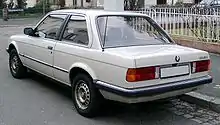
In 1985 the exterior and interior trim were updated. The 323i model was replaced with the 325i at this time and the diesel-engined 324d was introduced.[15] A factory convertible entered the model range. However, the Baur remained on sale, alongside the factory convertible. The M3 convertible was only offered for the European market.
Major update (1987)
_4-door_sedan_(2015-07-09)_02.jpg.webp)
At the Frankfurt Motor Show in September 1987, BMW introduced a major update to the E30 (often called Series 2).[15][16] The changes to the lineup were the addition of the Touring (station wagon) variant and removal of the 325e model. The 1987 update models remained largely unchanged until the end of production, with the addition of the 318is model in 1989.
External styling changes included redesigned rear lights, front bumper and a reduction in the amount of chrome trim.[16] The four-cylinder engine was upgraded from the BMW M10 to the BMW M40 and various other mechanical changes were made. Rust protection was improved with the update.
Body styles
In addition to the two-door sedan and Baur convertible body styles of its E21 predecessors, the E30 later also became available as a four-door sedan and five-door station wagon (marketed as "Touring").[17]
The Touring body style began life as a prototype built by BMW engineer Max Reisböck in his friend's garage in 1984 and began production in 1987.[18][19] The factory convertible version began production in 1985, with the Baur convertible conversions remaining available alongside it.[20]
 E30 two-door sedan
E30 two-door sedan.jpg.webp) E30 four-door sedan
E30 four-door sedan_convertible_(2011-03-10).jpg.webp) E30 convertible
E30 convertible.JPG.webp) E30 wagon
E30 wagon
Engines
Initially, the E30 used carryover four-cylinder (M10) and six-cylinder (M20) petrol engines from its E21 predecessor.[21] Over the production run, new families of four-cylinder petrol engines were introduced and the six-cylinder engine received various upgrades. A six-cylinder diesel engine was introduced, in both naturally aspirated and turbocharged forms.
Factory specifications are shown below.[22][23][24][25][26][27][28][29][30][31][32][33][34][35][36][37]
| Model | Years | Engine | Power | Torque |
|---|---|---|---|---|
| 316 | 1982-1987 | 1.8 L M10 inline-4 | 66 kW (90 PS; 89 hp) at 5,500 rpm | 140 N⋅m (103 lb⋅ft) at 4,000 rpm |
| 316i | 1987-1994 | 1.6 L M40 inline-4 | 73 kW (100 PS; 98 hp) at 5,500 rpm | 145 N⋅m (107 lb⋅ft) at 4,500 rpm |
| 318i | 1982-1987 | 1.8 L M10 inline-4 | 77 kW (105 PS; 104 hp) at 5,800 rpm | 145 N⋅m (107 lb⋅ft) at 4,500 rpm |
| 1987-1994 | 1.8 L M40 inline-4 | 83 kW (113 PS; 111 hp) at 5,500 rpm | 162 N⋅m (119 lb⋅ft) at 4,250 rpm | |
| 318is | 1989-1991 | 1.8 L M42 inline-4 | 100 kW (136 PS; 134 hp) at 6,000 rpm | 172 N⋅m (127 lb⋅ft) at 4,600 rpm |
| 320i | 1982-1985 | 2.0 L M20 inline-6 | 92 kW (125 PS; 123 hp) at 5,800 rpm | 170 N⋅m (125 lb⋅ft) at 4,000 rpm |
| 1985-1992 | 95 kW (129 PS; 127 hp) at 6,000 rpm | 164 N⋅m (121 lb⋅ft) at 4,300 rpm | ||
| 323i | 1982-1984 | 2.3 L M20 inline-6 | 102 kW (139 PS; 137 hp) at 5,300 rpm | 205 N⋅m (151 lb⋅ft) at 4,000 rpm |
| 1984-1985 | 110 kW (150 PS; 148 hp) 6,000 rpm | |||
| 325/e/es | 1985-1987 | 2.7 L M20 inline-6 | 90 kW (122 PS; 120 hp) at 4,250 rpm* |
240 N⋅m (177 lb⋅ft) at 3,250 rpm* |
| 1988 | 95 kW (129 PS; 127 hp) at 4,250 rpm | 205 N⋅m (151 lb⋅ft) at 3,200 rpm | ||
| 325i/is/ix | 1985-1993 | 2.5 L M20 inline-6 | 125 kW (170 PS; 168 hp) at 5,800 rpm** | 222 N⋅m (164 lb⋅ft) at 4,300 rpm** |
| M3 / M3 Evo 1 | 1986-1987 | 2.3 L S14 inline-4 | 143 kW (195 PS; 192 hp) at 6,750 rpm | 230 N⋅m (170 lb⋅ft) at 4,750 rpm |
| M3 Evo 2 | 1988 | 162 kW (220 PS; 217 hp) at 6,750 rpm | 245 N⋅m (181 lb⋅ft) at 4,750 rpm | |
| M3 Sport Evo | 1989-1990 | 2.5 L S14 inline-4 | 175 kW (238 PS; 235 hp) at 7,000 rpm | 240 N⋅m (177 lb⋅ft) at 4,750 rpm |
* With catalytic converter: 90 kW (122 PS; 120 hp), 230 N⋅m (170 lb⋅ft)
** Without catalytic converter: 126 kW (171 PS; 169 hp), 226 N⋅m (167 lb⋅ft)
| Model | Years | Engine | Power | Torque |
|---|---|---|---|---|
| 324d | 1985-1991 | 2.4 L M21 inline-6 | 63 kW (86 PS; 85 hp) at 4,600 rpm | 152 N⋅m (112 lb⋅ft) at 2,500 rpm |
| 324td | 1983-1991 | 2.4 L M21 inline-6 turbo | 85 kW (115 PS; 113 hp) at 4,800 rpm | 210 N⋅m (155 lb⋅ft) at 4,000 rpm |
Four-cylinder petrol
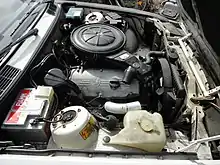
At the launch of the E30 range in 1982, the 316 used a 1766 cc version of the M10 fed by a carburetor and producing 66 kW (89 hp).[31][39] The 318i had the same M10 engine, but with Bosch L-Jetronic fuel-injection, increasing power to 77 kW (103 hp)[31][40] while also improving fuel economy.
The 1987 Series 2 update introduced a new four-cylinder engine: the M40, which used Bosch Motronic fuel-injection. In the 318i, a 1,796 cc (110 cu in) version of the M40 was used. The 316i model replaced the 316, using a 1,596 cc (97 cu in) version of the M40.
The 318iS was released in 1989, using the new M42 engine and only being available with two doors.[41][42] This is the most modern engine available in the E30 range, incorporating DOHC, the updated Bosch Motronic 1.3, hydraulic valve adjusters and coil-on-plug ignition. In some markets, the M42 engine was used in the 318i/318iC models, instead of the M40.
The M3 is powered by the S14 engine, a high-revving four-cylinder engine.[43][44]
Six-cylinder petrol
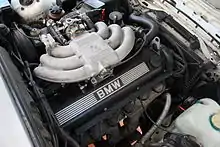
(325i version)
At the launch of the E30 range, the six-cylinder models consisted of the 320i, which had a 2.0 L (122 cu in) version of the M20 producing 92 kW (123 bhp),[45] and the 323i, with a 2.3 L (140 cu in) M20 producing 102 kW (137 bhp),[11][31] both using Bosch L-Jetronic fuel injection. These models were not sold in North America,[46] presumably for emissions reasons. In 1985, the 2.3 L engine was replaced with a 2.5 L version of the M20, which produced 125 kW (168 bhp) and used Bosch Motronic fuel injection.[33][47] This engine was available in the 325i variants, including the all-wheel drive 325iX.
An economy version called the 325e was released with a lower revving, more fuel efficient engine. The e is an abbreviation for eta, which is used to represent the thermal efficiency of a heat engine. To maximise low-rev torque, the 325e engine was the largest available in an E30 (aside from the 333i model, which was only sold in South Africa). The 325e engine had a longer stroke than the 325i version, with a more restrictive head, four cam bearings instead of seven, and single valve springs (instead of the dual valve springs used by the 325i version). For versions without a catalytic converter, the 325e engine produced 90 kW (121 bhp) at 4250 rpm and 240 N⋅m (177 lbf⋅ft) at 3250 rpm.[33][48] By comparison, peak torque for the 325i engine was 215 N⋅m (159 lb⋅ft) at 4000 rpm.
The 1987 Series 2 update boosted the 320i to 95 kW (127 hp) and the 325i to 125 kW (168 hp), and improved fuel economy.[49][50]
Six-cylinder diesel
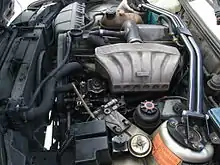
In 1983 the 324td was unveiled at the IAA, Germany. The M21 engine used a Garrett turbocharger (without an intercooler). The engine has a capacity of 2,443 cc (149 cu in) and uses mechanical fuel injection.
In 1985 BMW introduced the 324d, a naturally aspirated version of the same M21 engine, which was popular in countries with a high motor vehicle tax.[51]
In 1987 an electronically controlled fuel pump was used[52][53] which increased the torque output by 10 N⋅m (7 lb⋅ft). The updated engine has a smaller turbocharger, decreasing turbo lag.[54]
Drivetrain
In total, six transmissions were available for the various models of the E30: four manuals, and two automatics.
Manual transmissions
- 4-speed Getrag 242 — 316 and 318i models[55][56]
- 5-speed Getrag 240 — 316, 318i and 320i models[55][57] (with a different bellhousing for the 320i, to suit the BMW M20 engine).
- 5-speed Getrag 260 — 323i, 325e, 325es and 325i models.[55][58]
- 5-speed Getrag 265 — M3 model[55][59] (dog-leg shift pattern for European models and a standard H-pattern for North American models).[60]
Suspension
One of the features that added to the roominess of the E30 was the suspension. The front MacPherson struts and rear semi-trailing arm suspension were a compact arrangement that left a lot of cabin and boot space for the car's overall size. The semi-trailing arms have been criticized for the dynamic toe and camber changes inherent to the suspension geometry, causing bump steer in hard cornering situations (such as racing and autocross). Nonetheless, reviewers praised the handling of the E30.[63][64][65]
A widened version of the E30 front suspension and the drivetrain from the E30 325i were used in the BMW Z1 roadster. The BMW Z3 and BMW Compact (E36/5) rear suspensions are also very similar to the E30, but utilizing five-lug hubs. The Z3-based BMW M Coupé uses a widened version of the same rear semi-trailing arm suspension.
Brakes
For the front wheels, all models use disk brakes. For the rear wheels, most models use disk brakes, except for some 4-cylinder models which use drum brakes.[66] Anti-lock braking system (ABS) became available in 1986.[67]
Model range
United States & Canada
.JPG.webp)
The model range in the United States consisted of the following:
- 318i (1984-1985 using the M10 engine, then 1991 using the M42 engine)[68]
- 318is (1991 only)
- 325, 325e and 325es
- 325i, 325is (1987-1991 only)
- 325ix (1988-1991 only)
The primary distinctive feature of the BMW E30 models produced for the North American market in 1984–1987 is the protruding front and rear aluminum bumpers. These bumpers are commonly known as "diving boards."[69] In 1987, the anodized aluminum bumpers for the North American market were shortened by revising the cover/fillers and shortening the shock absorbers on which they were mounted. In mid-1988 (for model year 1989), shorter body-coloured plastic bumpers replaced the aluminium ones altogether.[70][71]
South Africa
In South Africa, only the two-door and four-door sedans were built, four cylinder gasoline (petrol) models production continued there until 1992.
Despite the introduction of the M40 engine, the old M10-powered 316 continued to be sold in South Africa until 1991, gaining the new bumpers when the range was updated.
The 333i is a South Africa-only model, and the South African 325iS models were a different specification from 325iS models sold in other countries.
M3 model
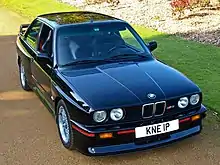
The BMW M3 utilised a widened and heavily redesigned variation of the two-door body style, therefore the M3 shares few body parts with other E30 models.[14] The M3 suspension is also significantly different from regular E30 models,[60] including five-lug wheel bolts.
Alpina models
.jpg.webp)
The Alpina C1, C2, B3 and B6 models were based on the E30.
Special models
320is

For Portugal and Italy only, due to considerably higher taxes for cars with engines exceeding 2000 cc, a special model was created: the 320is.[72] The four-door version appeared in the dealers' showrooms in September 1987 while the two-door followed in March 1988. Production of the 320is continued until 1991.
This model was equipped with a 1,990 cc (121 cu in) version of the S14 engine from the M3, with stroke reduced to 72.6 mm (2.86 in).[73] This engine produced 192 PS (141 kW) at 6900 rpm and 212 N⋅m (156 lb⋅ft) at 4,900 rpm.[73] The 320is shared the same dogleg Getrag 265 gearbox of the non-US M3 while it had a limited slip differential with the same 25% lock up rate but with a shorter differential ratio of 3.46:1.[74] All the 320is models were left hand drive and without a catalytic converter. Sports suspension was fitted to all two-door models, and to four-doors produced from September 1989.
The interior of the 320is was identical to that of other 3 Series models, except an M3 instrument cluster (which features an oil temperature gauge instead of a fuel economy gauge) was used. The 320is was sold for three years, with 1,206 four-doors and 2,542 two-doors produced.[75]
M325i
In New Zealand, where the M3 was never sold by BMW, the local importer created a sporting version of the sedan called M325i. About 100 such cars were imported beginning in late 1986 until at least 1990.[76] Fitted with the standard non-catalyzed 125 kW (168 bhp) 2.5 litre engine they benefited from a Motorsport tuned suspension, the M-Technic body package, 15-inch BBS cross-spoke wheels with wide, low profile (225/50) tyres, and a limited-slip differential.[76] The M325i is quite similar to the British market 325i Sport, also developed as a response to the absence of a right-hand-drive M3.
333i
BMW South Africa's Motorsport division created the 333i in 1985 by fitting the 3.2 L M30 "big six" engine to a two-door E30.[77] The resulting 333i was a success in South African saloon car racing. These cars were built with help from Alpina in Buchloe, Germany.[78][79] Due to the space constraints caused by the large M30 engine, the buyer was forced to choose between air conditioning (highly desirable in South Africa) and power steering. The 333i was produced from 1985 to 1987 and only 204 cars were produced.[80]
The 333i engine produces 145 kW (194 hp) at 5500 rpm and 285 N⋅m (210 lb⋅ft) at 4300 rpm.[80] BMW's official performance claims are 0–100 km/h (0–62 mph) in 7.4 seconds, and a top speed of 228 km/h (142 mph).[81]
South African 325iS
The 2.7 litre 325iS, commonly called Evo 1, was created by BMW South Africa to replace the 2.5 litre 126 kW 325i in Group N production car racing, as a response to the introduction of the Opel Kadett 2 litre 16V to the Class A category. It was launched in the first half of 1990 and was powered by an Alpina-fettled, 2.7 litre M20 engine which produced 145 kW (194 hp).[82] Following the introduction of the upgraded Opel Kadett 16V SuperBoss, in 1991 BMW South Africa introduced the 325iS Evolution HP, commonly referred to as the Evo 2. The motor was upgraded to produce 155 kW (208 hp).[82]
The Evolution HP won the Group N Class A title in 1993, winning 20 of the 24 races in the process.[83] The Robbi Smith and Geoff Goddard Evolution HP won the season-ending 9hr race.[84]
323i JPS
The John Player Special Edition is an Australian-only model built as a tribute to the M3,3 & 6 Series race cars competing in local touring car racing. JPS refers to the BMW race team sponsor, John Player Special cigarettes. The cars are based on a 323i manual "coupés",[85] painted in black with gold pinstripes and gold BBS wheels. They also had Recaro sports seats, JPS badging, a limited slip differential, sports suspension, a sunroof and a body kit.[86] The initial production run was 15 cars, with a small number of additional cars produced afterwards.[86]
Production
The E30 was produced in Munich, Germany; Regensburg, Germany; and Rosslyn, South Africa.[11][87][88] Series production began in October 1982.[89]
Models sold in Indonesia and Thailand used complete knock-down kits produced in Germany, which were assembled in Jakarta and Bangkok respectively.[90][91]
| Year | Units[92] |
|---|---|
| 1982 | 15,580 |
| 1983 | 218,201 |
| 1984 | 285,134 |
| 1985 | 297,886 |
| 1986 | 329,460 |
| 1987 | 316,075 |
| 1988 | 269,074 |
| 1989 | 257,307 |
| 1990 | 246,818 |
| 1991 | 56,363 |
| 1992 | 26,913 |
| 1993 | 18,440 |
| 1994 | 1,997 |
| Total [94] | 2,433,000 |
Production of the E30 began to wind down in 1990, due to the introduction of the E36 3 Series coupé models. Sedan production concluded on April 30, 1991 at Regensburg. Other variants were phased out gradually, until the final E30 model, a Touring, was produced in 1994, and sold as a 1995 model year.[95]
Motorsport
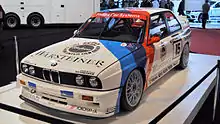
The E30 M3 had a very successful career in Touring car racing.[96][97][98]
The E30 remains a popular car for racing[99][100][101] and E30-specific racing series such as the National Auto Sport Association's Spec E30 class are run in the United States, Australia and New Zealand.[102][103][104]
Television feature appearances
- Wheeler Dealers Season 2 Episode 7 includes a 325i Touring.[105]
- In the Top Gear television series Season 16 Episode 4, the presenters entered a challenge for 4-seat convertibles costing under £2000. All 3 presenters purchased E30 325i convertibles.[106]
References
- "Internal And External Dimensions The most important data" (JPG). BMW. 1990. Retrieved 18 February 2019.
- "Specifications 316i; 318i" (JPG). BMW. 1990. Retrieved 18 February 2019.
- "Specifications 318is; 320iSE; 325iSE; 325i sport" (JPG). BMW. 1990. Retrieved 18 February 2019.
- "BMW 3 Series Coupe (E30) specs & photos". www.autoevolution.com. Retrieved 9 March 2019.
- "BMW 3-Series (1982 - 1990)". www.honestjohn.co.uk. Retrieved 9 March 2019.
- "BMW M3 E32 2.5i (238Hp) EVO II". www.automobilio.info.
- "BMW Car Designers". www.bmwism.com. Archived from the original on 18 October 2012. Retrieved 24 February 2019.
- "25 Most Iconic Sports Cars Ever - BMW E30". www.drivezing.com. 15 April 2019. Retrieved 13 June 2020.
- Series, BMW 3. "Classic Ads: BMW 3 Series (E30)". www.motor1.com. Retrieved 24 February 2019.
- "BMW Typen". www.auto-im-vergleich.de. Retrieved 18 March 2018.
- "Bericht: 30 Jahre BMW 3er (E30)". ww2.autoscout24.de. Retrieved 29 December 2017.
- "Hommage an Claus Luthe". www.kulturgut-mobilitaet.de. Archived from the original on 2014-09-14.
- Noakes, Andres (2008). The Ultimate History of BMW. p. 117.
- "BMW 3 Series History". www.edmunds.com.
- "BMW 3-Series E30 versions, models & types". www.automobile-catalog.com.
- Baghetti, Giancarlo (1987-12-17). Liberali, Sandro (ed.). "Che diesel volete?" [Which diesel do you want?]. Auto Oggi (in Italian). Verona, Italy: Arnoldo Mondadori. 2 (54): 17, 19.
- Lewin, Tony (2016). The BMW Century. p. 98. ISBN 978-0-7603-5017-1.
- "The story behind the BMW 3-Series (E30) Touring". www.ranwhenparked.net. Retrieved 16 December 2017.
- "3' E30 - Touring - 325i - Europe - model selection". www.realoem.com. Retrieved 24 February 2019.
- "3'E30 - Convertible - 325i - Europe - model selection". www.realoem.com. Retrieved 24 February 2019.
- "BMW E30 Specifications". www.e30world.com. Archived from the original on 2013-02-24.CS1 maint: unfit URL (link)
- "Specifications for BMW 316 E30 Sedan (1982-1987)". www.bmwheaven.com. Retrieved 22 December 2017.
- "Specifications for BMW 316i E30 LCI Sedan (1988-1991)". www.bmwheaven.com. Retrieved 22 December 2017.
- "Specifications for BMW M3 E30 Sedan (1986-1989)". www.bmwheaven.com. Retrieved 22 December 2017.
- "Specifications for BMW M3 evo 1 E30 Sedan (1987-1987)". www.bmwheaven.com. Retrieved 22 December 2017.
- "Specifications for BMW M3 evo 2 E30 Sedan (1988-1988)". www.bmwheaven.com. Retrieved 22 December 2017.
- "Specifications for BMW 320i E30 Sedan (1982-1985)". www.bmwheaven.com. Retrieved 22 December 2017.
- "Specifications for BMW 323i E30 Sedan (1982-1984)". www.bmwheaven.com. Retrieved 22 December 2017.
- "Specifications for BMW 324d E30 Sedan (1985-1991)". www.bmwheaven.com. Retrieved 22 December 2017.
- "Specifications for BMW 324td E30 LCI Sedan (1987-1991)". www.bmwheaven.com. Retrieved 22 December 2017.
- BMW E30 3 Series 1982 Brochure. BMW AG. 1982. p. 13. Retrieved 22 December 2017.
- BMW E30 3 Series Brochure 1984. BMW AG. 1984. pp. 47–48. Retrieved 22 December 2017.
- BMW E30 3 Series Brochure 1985. BMW AG. 1985. pp. 31–33. Retrieved 22 December 2017.
- BMW E30 3 Series Brochure 1987. BMW AG. 1987. pp. 27–28. Retrieved 22 December 2017.
- BMW E30 3 Series Brochure 1988. BMW AG. 1988. pp. 27–28. Retrieved 22 December 2017.
- BMW E30 3 Series Brochure 1989. BMW AG. 1989. pp. 27–28. Retrieved 22 December 2017.
- "E30 M3 FAQ". BMW M Registry. Retrieved 22 December 2017.
- BMW E30 3 Series Diesel Brochure 1988. BMW AG. 1988. p. 21. Retrieved 23 December 2017.
- Dibrani, Ilir. "Specifications for BMW 316 E30 Sedan (1982-1987)". www.bmwheaven.com. Retrieved 2017-12-22.
- Dibrani, Ilir. "Specifications for BMW 318i E30 Sedan (1983-1988)". www.bmwheaven.com. Retrieved 22 December 2017.
- "BMW 318is Motive als Dias". bmw-grouparchiv.de. BMW AG. Retrieved 23 December 2017.
- "3'E30 318is model selection". www.realoem.com. Retrieved 23 December 2017.
- "BMW World - BMW S14 Engine". www.usautoparts.net. Archived from the original on 29 March 2012.
- "FAQ E30 M3". www.bmwmregistry.com. Retrieved 21 December 2017.
- Everett, Andrew (2012). BMW E30 - 3 Series Restoration Guide. PublishDrive. p. 324. ISBN 9781855209602. Retrieved 22 December 2017.
- "This Is What A 1985 BMW E30 Looks Like With Just 162 Miles On The Clock". www.jalopnik.com. Retrieved 24 February 2019.
- "BMW 325i (1985) detailed specifications and photo gallery". www.automobile-catalogue.com. Archived from the original on 2012-01-06. Retrieved 2013-06-16.
- Dibrani, Ilir. "Specifications for BMW 325e E30 Sedan (1985-1987)". www.bmwheaven.com. Retrieved 22 December 2017.
- "Specifications for BMW 320i E30 Sedan (1985-1991)". www.bmwheaven.com. Retrieved 22 December 2017.
- "Specifications for BMW 325i E30 LCI Touring (1987-1992)". www.bmwheaven.com. Retrieved 22 December 2017.
- "30 years ago: BMW introduces its first diesel engine". www.ranwhenparked.net. 22 July 2013. Retrieved 24 February 2019.
- "BMW M21 Six Cylinder Diesel Engines". www.unixnerd.demon.co.uk. Retrieved 24 February 2019.
- "M21". www.e30zone.net. Retrieved 24 February 2019.
- "Die BMW-Sportdiesel: Von 524td E28 über 530d E39 bis BMW M550d F10". www.bimmertoday.de (in German). 21 January 2012. Retrieved 24 February 2019.
- Everett, Andrew (2012). BMW E30 - 3 Series Restoration Guide. PublishDrive. pp. 141–142. ISBN 9781855209602. Retrieved 22 December 2017.
- "3' E30 318i Manual gearbox". www.realoem.com. Retrieved 6 December 2017.
- "3' E30 318i Manual gearbox". www.realoem.com. Retrieved 6 December 2017.
- "3' E30 325i Manual gearbox". www.realoem.com. Retrieved 6 December 2017.
- "3' E30 M3 Manual gearbox". www.realoem.com. Retrieved 6 December 2017.
- "FAQ E30 M3". www.bmwmregistry.com.
- "3' E30 318i Automatic gearbox 3HP22". www.realoem.com. Retrieved 26 November 2017.
- "3' E30 318i Automatic gearbox 4HP22". www.realoem.com. Retrieved 26 November 2017.
- "The 7 best BMW 3 Series of all time". www.roadandtrack.com. Retrieved 18 December 2017.
- "1987 BMW 325i values". www.hagerty.com. Retrieved 18 December 2017.
- "3-Series (E30) - Classic car review". www.honestjohn.co.uk. Retrieved 18 December 2017.
- "3' E30 316 Drum brake-brake shoes/brake carrier". www.realoem.com. Retrieved 28 July 2020.
- BMW 3 Series Service Manual 1984-1990. Bentley Publishers. 1990. pp. 1–10. ISBN 0-8376-0325-0.
- "Model Selection - 3'E30 - 4 doors - 318i - USA - 02/1991". www.realoem.com. Retrieved 3 July 2019.
- "Aluminum bumper tuck". www.strictlyeta.net.
- "BMW E30 Bumpers and Grilles". www.pelicanparts.com. Retrieved 2019-08-24.
- "3' E30 325i Bumper, front". www.realoem.com. Retrieved 2019-08-24.
- "BMW 320is E30: Import Only". www.classicandperformancecar.com. Retrieved 4 December 2017.
- "Euro E30 320iS S14 tech specs". www.bmwe21.net. Retrieved 4 December 2017.
- "For $40,000, This 1988 BMW 320is Could Be Your Latin Lover". www.jalopnik.com. Retrieved 4 December 2017.
- "FAQ 320is". www.bmwmegistry.com. Retrieved 4 January 2017.
- Clews, Andrew (April 1993). "Buying Used: BMW M325i". New Zealand Car. Auckland, New Zealand: Accent Publishing Cnr. 7 (6): 68–69. ISSN 0113-0196.
- "333i E30". www.africanmusclecars.com. Retrieved 4 January 2017.
- "333i". www.e30zone.net. Retrieved 30 November 2017.
- "Rare 1985 BMW Alpina 333i Up for Sale". www.autoevolution.com. Retrieved 30 November 2017.
- "1985 BMW 333i E30 specifications, information, data, photos 55957". www.carfolio.com. Retrieved 4 January 2017.
- "BMW Super Bild Of The Day: E30 333i". www.bmwblog.com. Retrieved 4 January 2017.
- "325iS South African Model". www.e30zone.net. Retrieved 22 December 2017.
- "3½ Decades of BMW Motorsport in South Africa". www.drive-my.com. Retrieved 22 December 2017.
- "JSN Motors BMW E30 325i Shadowline and 325iS Evo II". www.evolution2.co.za. Retrieved 22 December 2017.
- "Used car research- BMW E30 John Player Special". www.redbook.com. Retrieved 2 January 2018.
- "BMW 323i 'JPS' E30 Coupe Auctions - Lot 4 - Shannons". Shannons Insurance. Retrieved 4 January 2017.
- "BMW Group Plant Regensburg". www.bmwgroup-plants.com (in German). Retrieved 29 December 2017.
- "CKD Montage". Retrieved 24 March 2018.
- https://www.autoscout24.de/informieren/news/bericht-30-jahre-bmw-3er-e30/
- "CKD Montage". e12.de. Retrieved 24 March 2018.
- "Thaïlande". e12.de. Retrieved 24 March 2018.
- Oswald, Werner (2001). Deutsche Autos 1945–1990, Band 4 (1. ed.). Stuttgart: Motorbuch Verlag. ISBN 3-613-02131-5.
- Kittler, Eberhard (2001). Deutsche Autos seit 1990, Band 5 (1. ed.). Stuttgart: Motorbuch Verlag. ISBN 3-613-02128-5.
- Bowen, Robert (2013). BMW 3-Series (E30) performance guide 1982-1994. CarTech Books. p. 7. ISBN 978-1-934709-86-3.
- "E30 model selection: 318i Touring". www.realoem.com. Retrieved 9 March 2017.
- "1986 BMW M3 Review". www.topspeed.com. Retrieved 20 October 2017.
- "BMW M3: A Brief History of the Ultimate Driving Machine". www.motortrend.com. Retrieved 20 October 2017.
- "Meet The Legend: E30 M3". www.bmwblog.com. Retrieved 20 October 2017.
- "Why a 25-Year-Old BMW Is the Perfect First Race Car". www.roadandtrack.com. Retrieved 20 October 2017.
- "How To Get Your BMW E30 Accepted For a LeMons Race: Bavarian Ranchero". www.jalopnik.com. Retrieved 20 October 2017.
- "24 Hours of LeMons announces 2009 Season Champions". www.autoblog.com. Retrieved 20 October 2017.
- "Welcome to SpecE30". www.spece30.com. Archived from the original on 2017-11-01. Retrieved 20 October 2017.
- "About E30 Racing". www.e30racing.com.au. Archived from the original on 26 July 2018. Retrieved 20 October 2017.
- "BMW Race Driver Series | New Zealand's BMW Race Driver Series". www.bmwraceseries.co.nz. Retrieved 2018-06-26.
- ""Wheeler Dealers" BMW E30 325i Touring Part 1". www.imdb.com. Retrieved 20 October 2017.
- "Top Gear Series 16 Episode 4". www.topgear.com. Archived from the original on 31 July 2013.
Further reading
| Wikimedia Commons has media related to BMW E30. |
- Jeremy Walton (2001). BMW 3-Series Collectors Guide: Generation 1 and 2 including M3. Motor Racing Publications. ISBN 1-899870-55-5.
- R.M. Clarke (1990). BMW Series 3 - 4 Cylinder Cars Gold Portfolio. Brooklands Books. ISBN 1-85520-149-6.
- A.K. Legg & Larry Warren (1996). BMW 3- & 5-Series Haynes Service and Repair Manual. Haynes. ISBN 1-85960-236-3.
- Various authors (1993). "BMW Serie "3" (Modelos después 1983) Estudios técnicos y documentación". Revista Técnica del Automóvil. ANETO-ETAI. ISSN 1134-7155.
- Andrew Everett (2006). BMW E30 - 3 Series Restoration Bible. Brooklands Books. ISBN 1-85520-678-1.
- Robert Bentley (2003). BMW 3 Series (E30) Service Manual: 1984–1990. Bentley Publishing. ISBN 0837603250.